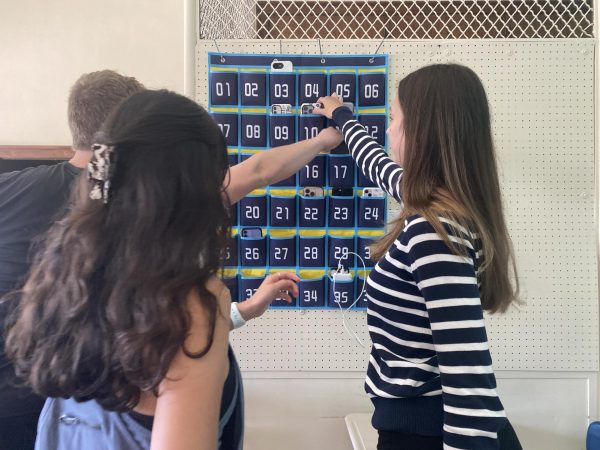Culture shifts from Coachella to Lane
Cultural Appropriation (n.)
[kuhl-cher-uh l]-[uh-proh-pree-ey-shuh n]
A term used to describe the taking over of creative or artistic forms, themes, or practices by one cultural group from another. It is in general used to describe Western appropriations of non‐Western or non‐white forms, and carries connotations of exploitation and dominance.
The Coachella Valley Music and Arts festival, which takes place in California throughout the Spring season, is known for its fashion style, most recently boho chic. Teenagers are known to wear clothing and accessories from a variety of cultures; from a simple traditionally Indian bindi to a Native American tribal head-band. The trend seen at Coachella is often seen here, at Lane.
When spring rolls around, teenagers turn to new clothing trends, many which have a Coachella-esque feel. Many find these accessories and clothing lines significant to cultural appropriation, which means taking elements of one’s culture and adopting them as your own, and many, do not believe this is a relevant matter.
“I see cultural appropriation about four times a week and I never really think anything of it. I think it’s weird and move on,” Emmanuel Adetayo, Div. 669, said.
One of these culturally appropriated accessories is the bindi, which is a traditional facial wear that many Indian women wear on their forehead. It can signify multiple things, from purity to marriage. However, through social media, many have objectified the use of the bindi on non-Indian women.
“You can’t tell people what to wear and what not to wear, obviously. Honestly, if you’re using the bindi in your everyday life, like at Coachella, I have a problem with that. It is not just a fashion statement, there’s history behind it,” Samrudhi Vaghmare, Div. 583, said.
The hashtag #reclaimthebindi is trending everywhere online, from Twitter to Tumblr. Many have expressed their objections through posting pictures of themselves in traditional clothing.
“I can’t represent all the Indians, but #reclaimthebindi has,” Vaghmare said.
As cultural trends further make their way into media, many have made cultural patterns a part of their daily life.
“I think it’s okay to accept other cultures and embrace them as your own, as long you’re respective of other cultures,” said Yesenia Suptelya, Div. 769.
However, even Lane has been subject to protest, because of the infamous Indian mascot, in past years.
“I am not Native American and I can’t decide what they consider to be culturally appropriated for them, but if there is a large majority [of Native Americans] that are offended, then it is time to change that,” Vaghmare said.
Recently, actress Amandla Stenberg, who played Rue in the movie, The Hunger Games, and a classmate from her school created a video. They discussed the history of black cultural appropriation through a lesson called “Don’t Cash Crop On My Cornrows.”
“Appropriation occurs when a style leads to racist generalizations or stereotypes where it originated but is deemed as high fashion, cool, or funny when the privileged take it for themselves,” Stenberg said.
Grey (Chloe) Sherwin, Div. 671, said she does not support cultural appropriation, but believes cultural exchange- exchanging information about differing backgrounds- is a healthy experience.
“America is so diverse, we can’t nestle the country into a little bubble. Society needs to branch out, and experience things first hand rather than through a television. Interact, and then read about the culture. Don’t go blindly towards a trend and be misinformed.”
The Kardashians have also been accused of encouraging black cultural appropriation in media, through Kylie Jenner and the“lip challenge” that takes after her physical attributions. In the last year, as her lips have expanded greatly, so did her fame and rumors about her surgery.
“It’s a horrible trend. The appropriation here is when you try and justify it. Like ‘oh I have big lips ‘cause it’s what’s trending now, I like it on me,’ but you’re ignoring all the other history behind it, you’re ignoring the people who used to be made fun of for that one feature,” Vaghmare said.
The trend has been widely accepted by teenagers and for those who tried the “lip-challenge,” but has resulted in a wounded face.
What some consider cultural appropriation, others consider a mindless trend. What some consider an offense to their traditional values, others consider a universal way to express themselves.
“You can’t pick out something you like from a culture and wear it for your own purposes. You’re taking advantage of it, exploiting it, breaking it down, and only taking out what you like,” said Vaghmare.
Your donations directly fund the Lane Tech student journalism program—covering essential costs like website hosting and technology not supported by our school or district. Your generosity empowers our student reporters to investigate, write, and publish impactful stories that matter to our school community.
This website is more than a publishing platform—it's an archive, a research tool, and a source of truth. Every dollar helps us preserve and grow this resource so future students can learn from and build on the work being done today.
Thank you for supporting the next generation of journalists at Lane Tech College Prep!

Anum Shafqat is the Editor-in-Chief of The Warrior. She has been pursuing journalism in high school for three years. With a love for television, red velvet...




